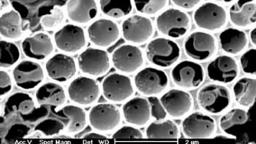Membrane Science: membrane fabrication, systems development, optimization, cost modeling, applications (membrane distillation, water treatment, desalination, water reuse, fuel cell development).
Membrane Science
Summaries of Selected Research Efforts
Colloidal Fouling of Membrane Filters
Colloidal fouling of membranes has been a central topic of research in our group for the last 10 years. We proposed a view of particle transport in membranes that unifies models for mass transport and particle fluid mechanics.

Environmentally Benign Synthesis of Alumina Based Ceramics
Ceramic membranes are promising in applications such as treating hazardous and industrial wastes, or recovering materials during chemical production that may, due the presence of solvents or high temperatures, destroy conventional polymeric membranes. Our group is focused on developing and characterizing an entirely new class of ceramic membranes based on alumoxane chemistry for applications in environmental separations.
Membrane Cost Modeling
As emerging technologies, there are many unknowns regarding the cost-effectiveness of membrane processes such as ultrafiltration (UF) and nanofiltration (NF) for potable water treatment.
Membrane Filtration of Secondary Wastewater
This pilot study was designed to evaluate the efficacy of membrane microfiltration in treating secondary wastewater effluent conditioned with various inorganic coagulants.
Numerical Simulation of Membrane Processes
Numerical representations of membrane performance will ultimately allow us improve membrane facility design, operator training, and process control. This work considers dominant mechanisms of particle transport in crossflow membrane filtration which are unified to obtain a generalized model for time-dependent permeate flux.
pH and Ionic Strength Effects on Ceramic Membranes
The permeate flux of clean a-alumina membranes is affected significantly by the pH of the feed stream. The 0.8 µm membrane used in this work operated at a significantly higher permeation rate at a pH well below the i.e.p. of the membrane.
Treatment of Produced Waters by Ultrafiltration
Produced water from gas and oil operations is purportedly the largest single source of waste generated in the United States with an annual production rate of over 3 billion tons. Results are presented from bench scale pilot tests of membrane ultrafiltration of produced waters obtained from three operating oil and gas wells.